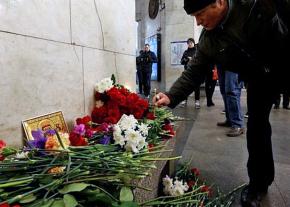The roots of the Russian subway bombing
A suicide bomber set off a blast in a subway train in the Russian city of St. Petersburg on April 3, killing 14 people and injuring dozens more. A second, larger bomb was defused. The bomber was identified as 22-year-old Akbarjon Djalilov, from Kyrgyzstan, one of the central Asian countries that were once republics of the USSR.
The Russian government led by President Vladimir Putin immediately labeled the attack the work of "Islamic terrorists." This has been a familiar theme during Putin's highly repressive reign. Islamist organizations have been a main part of the resistance to Putin's draconian crackdown and worse within the Russian Federation--for example, in Chechnya in the Caucasus region of Southwestern Russia, where the Russian military twice laid waste to whole cities in combatting an insurgency.
This isn't the first suicide bombing in a major Russian city, but the identity of the suicide bomber has shifted attention from the Caucasus region further east to the large central Asian countries that gained independence after the collapse of the USSR in 1991, but remain connected and subordinate to Russia. writes from Russia to provide background on the desperate conditions in Central Asia that give rise to violence, in an article written for Italy's Il Manifesto newspaper, and translated by Doniella Maher.
THE THREAT of terrorism committed by Islamist organizations in Russia doesn't come only from the North Caucasus, but also from central Asian countries. Thus, the main suspect in the St. Petersburg subway bombing is from Kyrgyzstan.
In the republics of Central Asia--and in particular, Uzbekistan, Tajikistan and Kyrgyzstan--there has been, since the 1990s, a re-emergence of fundamentalism and the birth of strong Islamist organizations. In the rest of the central Asian region, the long borders of China, Russia, Iran and Afghanistan have created a magnet for many Islamist groups and a route for the trafficking of narcotics.
The regimes that have been imposed in these states after the fall of the USSR are characterized by nepotism, corruption and mismanagement of public affairs, retaining the old vices of the old Stalinist bureaucracy. In fact, the new regimes are generally still governed by the same politicians who 30 years ago abandoned the roles of functionaries of the Communist Party and embraced those of managers of neoliberalism.

Chronic unemployment and the collapse of the old Soviet welfare state have forced many citizens of these states to emigrate to Russian and European cities, where they are now at the bottom rung of the social and economic ladder. Uzbekistanis, Tajiks and Kyrgs find themselves in some of the most difficult and poorly paid occupations and are often the objects of xenophobic attacks and pogroms.
Overall, the elite of these countries have retained the traditional secularism. None have declared Islam the state religion, and they have maintained the separation between church and state. The objective was, and is, to impede the emergence of any potential threats to the direction of their governments.
Through collaborating with Russian authorities for many years, they have been able to constrict the political and military activity of armed Islamist groups, which has stayed at a low level. The number of Jihadist militants who have gone to Russia has remained limited.
The relative influence of radical Islam in the region has for a long time been the product of internal divisions over the interpretation of the Koran, the relationship with modernity and the use of violence as an instrument of struggle. Despite this, the failure of the political establishment to create economic development, the absence of social mobility, and the regimes' political repression have given new impetus to fundamentalist groups in the region.
KYRGYSTAN IS a good example.
According to the United Nations Development Program, the country's basic institutions, like the education system, have been collapsing for years. One-third of the population is under the poverty line, and the median salary is equivalent to $190 a month. Nearly 20 percent of the population has emigrated to Russia, and the earnings sent back to their families represent 30 percent of gross domestic product. The frequent nationalist clashes with the neighboring Uzbekistani population have already threatened the stability of a diverse society with dozens of ethnicities.
The Islamic groups represent a call for a tentative, if distorted, attempt to give social cohesion to the country. Hizb ut-Tahrir, a Salafist group that officially refutes the use of violence, but has been outlawed for its links to ISIS, has thousands of supporters in the country.
Since 2015, ISIS has reportedly circulated a propaganda video to recruit fighters for the war in Iraq and Syria. In September 2016, a car bomb was used to attack the Chinese embassy in the Kyrgystan capital. The 26-year-old responsible was identified as a militant of the Eastern Turkistan Islamic Movement.
In this context, we cannot be surprised that Kyrgs have been recruited to ISIS to fight in Syria. According to reports, of the 3,000 to 4,000 ISIS combatants from the central Asian countries, 800 are from Kyrgyzstan.
The possible ending of the conflict in Syria with a victory for the regime has, paradoxically, created major internal dangers to Putin's Russia. A large percentage of the ex-fighters from Syria are now re-entering illegally and trying to find additional converts within the Kyrg, Uzbeki, and Tajik communities.
The devastated economic crisis that has hurt Russia for the last two years has done nothing to diminish the suffering and frustration of Muslim residents, many of whom are naturalized citizens of Russia, and this in turn gives new lifeblood to extremist groups.
This is also why the harshly repressive response from the Russian government is myopic and counterproductive--and could open new and profound tensions in Russia and nearby regions.


